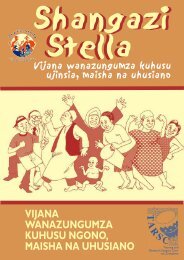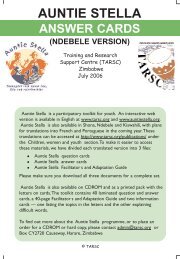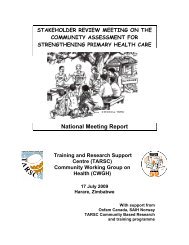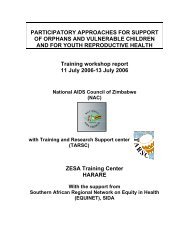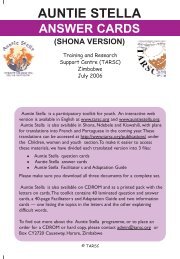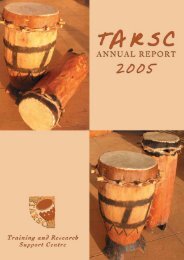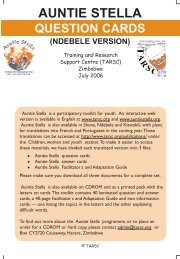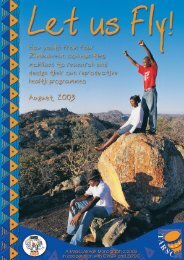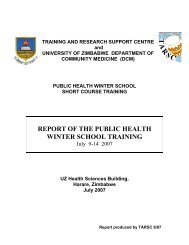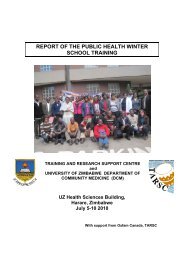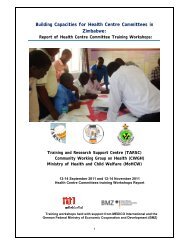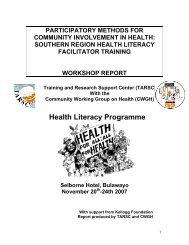BEAM rep final.pdf - Training and Research Support Centre
BEAM rep final.pdf - Training and Research Support Centre
BEAM rep final.pdf - Training and Research Support Centre
You also want an ePaper? Increase the reach of your titles
YUMPU automatically turns print PDFs into web optimized ePapers that Google loves.
Executive Summary<br />
The Basic Education Assistance Module (<strong>BEAM</strong>) is one of the important pro-poor funds that are<br />
meant for the marginalised <strong>and</strong> vulnerable communities in Zimbabwe. <strong>BEAM</strong> is a programme<br />
that provides school fees, examination fees, levies <strong>and</strong> building assistance. It was introduced by<br />
the Government of Zimbabwe in 2001. It targets the vulnerable children who are unable to pay<br />
school fees or those who fail to go to school as a result of non-availability of money. According<br />
to a 2012 <strong>BEAM</strong> evaluation <strong>rep</strong>ort, of the estimated 3.6 million children of school going age<br />
(primary <strong>and</strong> secondary) in Zimbabwe, approximately 1 million of them are in need of financial<br />
assistance. Out of the 2.8 million primary school going children an estimated 28% of them are in<br />
need of fund assistance. However, only 16% are received the funds in the previous year. For<br />
secondary schools pupils the <strong>rep</strong>ort notes that about 24% children needed assistance with only<br />
17% receiving the assistance.<br />
Apart from inadequate funds to pay for those in need, there are a number of fund management,<br />
accounting <strong>and</strong> governance issues that have affected the programme since its inception. Prior<br />
to this work the <strong>Training</strong> <strong>and</strong> <strong>Research</strong> <strong>Support</strong> <strong>Centre</strong> (TARSC) carried out a pilot survey on<br />
<strong>BEAM</strong> <strong>and</strong> identified a number of issues affecting its operations that require closer monitoring<br />
<strong>and</strong> evaluation of the schools on the use of funds by their parent ministry, the funding ministry<br />
(Ministry of Labour <strong>and</strong> Social Welfare) <strong>and</strong> other funding agencies. The pilot survey noted that<br />
selection of beneficiaries was cumbersome <strong>and</strong> prone to manipulation. The administration of the<br />
programme was perceived as not transparent in some schools.<br />
To assess some of these operational challenges <strong>and</strong> offer some suggestions to improve the<br />
administration of <strong>BEAM</strong>, TARSC in association with Zimbabwe Teachers Association (ZIMTA)<br />
carried out a survey to assess the general underst<strong>and</strong>ing of the <strong>BEAM</strong> programme by those<br />
who are executing it <strong>and</strong> benefiting from it at the local district level.<br />
A cross sectional survey was implemented in 10 districts selected on the basis of vulnerability<br />
from nine out of the ten provinces of Zimbabwe. The survey obtained information from 200 key<br />
informants (school Heads, bursars <strong>and</strong> accounts clerks), <strong>and</strong> 189 beneficiaries through<br />
structured interviews. It assessed the availability <strong>and</strong> use of <strong>BEAM</strong> guidelines in schools, the<br />
criteria for selection of beneficiaries <strong>and</strong> the underst<strong>and</strong>ing of the selection guidelines by the<br />
school authorities <strong>and</strong> selection committees, the accounting <strong>and</strong> auditing of the <strong>BEAM</strong> funds<br />
<strong>and</strong> the organs that carry out the auditing, the frequency of those audits <strong>and</strong> the disbursements<br />
<strong>and</strong> absorption of funds by the Ministry of Finance <strong>and</strong> schools respectively. ZIMTA provided all<br />
the research assistants that were used in the survey drawn from all the nine participating<br />
districts of Zimbabwe. TARSC provided the technical inputs, training, analysis <strong>and</strong> <strong>rep</strong>orting.<br />
The Open Society Initiative for Southern Africa (OSISA) provided the funding for the survey..<br />
The research assistants from ZIMTA were trained for a day on how to administer the key<br />
informant <strong>and</strong> beneficiary questionnaires.<br />
Results from the survey showed that <strong>BEAM</strong> support was valued by beneficiaries <strong>and</strong> schools.<br />
The funds allocated to the <strong>BEAM</strong> programme were however found to be inadequate relative to<br />
need. Of the 15 243 potential beneficiaries in the participating schools’ registers, only 8533<br />
(56%) were receiving <strong>BEAM</strong> assistance as a result of inadequate funds.<br />
Faced with a large number of potential beneficiaries versus limited resources, there were issues<br />
of non coverage of people in need <strong>and</strong> issues raised on funds were allocated to those who did<br />
receive. About a third (38.1%) of community elders interviewed observed that schools did not<br />
display a list of the <strong>BEAM</strong> beneficiaries on the public notice board. The public display of names<br />
2



